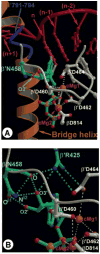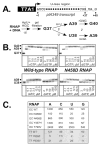Discrimination against deoxyribonucleotide substrates by bacterial RNA polymerase
- PMID: 15262972
- PMCID: PMC3131404
- DOI: 10.1074/jbc.C400316200
Discrimination against deoxyribonucleotide substrates by bacterial RNA polymerase
Abstract
Nucleic acid polymerases have evolved elaborate mechanisms that prevent incorporation of the non-cognate substrates, which are distinguished by both the base and the sugar moieties. While the mechanisms of substrate selection have been studied in single-subunit DNA and RNA polymerases (DNAPs and RNAPs, respectively), the determinants of substrate binding in the multisubunit RNAPs are not yet known. Molecular modeling of Thermus thermophilus RNAP-substrate NTP complex identified a conserved beta' subunit Asn(737) residue in the active site that could play an essential role in selection of the substrate ribose. We utilized the Escherichia coli RNAP model system to assess this prediction. Functional in vitro analysis demonstrates that the substitutions of the corresponding beta' Asn(458) residue lead to the loss of discrimination between ribo- and deoxyribonucleotide substrates as well as to defects in RNA chain extension. Thus, in contrast to the mechanism utilized by the single-subunit T7 RNAP where substrate selection commences in the inactive pre-insertion site prior to its delivery to the catalytic center, the bacterial RNAPs likely recognize the sugar moiety in the active (insertion) site.
Figures



Similar articles
-
Structural basis for substrate selection by t7 RNA polymerase.Cell. 2004 Feb 6;116(3):381-91. doi: 10.1016/s0092-8674(04)00059-5. Cell. 2004. PMID: 15016373
-
The mechanism of the nucleo-sugar selection by multi-subunit RNA polymerases.Nat Commun. 2021 Feb 4;12(1):796. doi: 10.1038/s41467-021-21005-w. Nat Commun. 2021. PMID: 33542236 Free PMC article.
-
Mechanism of sequence-specific pausing of bacterial RNA polymerase.Proc Natl Acad Sci U S A. 2009 Jun 2;106(22):8900-5. doi: 10.1073/pnas.0900407106. Epub 2009 Apr 24. Proc Natl Acad Sci U S A. 2009. PMID: 19416863 Free PMC article.
-
RNA polymerase fidelity and transcriptional proofreading.Curr Opin Struct Biol. 2009 Dec;19(6):732-9. doi: 10.1016/j.sbi.2009.10.009. Epub 2009 Nov 13. Curr Opin Struct Biol. 2009. PMID: 19914059 Review.
-
The Extended "Two-Barrel" Polymerases Superfamily: Structure, Function and Evolution.J Mol Biol. 2019 Sep 20;431(20):4167-4183. doi: 10.1016/j.jmb.2019.05.017. Epub 2019 May 17. J Mol Biol. 2019. PMID: 31103775 Review.
Cited by
-
Antibacterial Nucleoside-Analog Inhibitor of Bacterial RNA Polymerase.Cell. 2017 Jun 15;169(7):1240-1248.e23. doi: 10.1016/j.cell.2017.05.042. Cell. 2017. PMID: 28622509 Free PMC article.
-
Regulation of Transcript Elongation.Annu Rev Microbiol. 2015;69:49-69. doi: 10.1146/annurev-micro-091014-104047. Epub 2015 Jun 24. Annu Rev Microbiol. 2015. PMID: 26132790 Free PMC article. Review.
-
Active site opening and closure control translocation of multisubunit RNA polymerase.Nucleic Acids Res. 2012 Aug;40(15):7442-51. doi: 10.1093/nar/gks383. Epub 2012 May 8. Nucleic Acids Res. 2012. PMID: 22570421 Free PMC article.
-
A revised mechanism for (p)ppGpp synthesis by Rel proteins: The critical role of the 2'-OH of GTP.J Biol Chem. 2020 Sep 11;295(37):12851-12867. doi: 10.1074/jbc.RA120.013636. Epub 2020 Jul 21. J Biol Chem. 2020. PMID: 32719004 Free PMC article.
-
Stepwise mechanism for transcription fidelity.BMC Biol. 2010 May 7;8:54. doi: 10.1186/1741-7007-8-54. BMC Biol. 2010. PMID: 20459653 Free PMC article.
References
-
- Yang G, Franklin M, Li J, Lin TC, Konigsberg W. Biochemistry. 2002;41:10256 –10261. - PubMed
Publication types
MeSH terms
Substances
Grants and funding
LinkOut - more resources
Full Text Sources
Other Literature Sources

